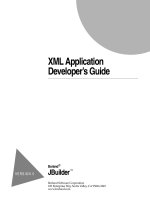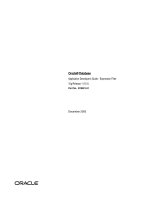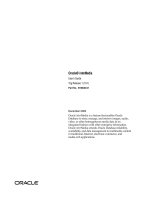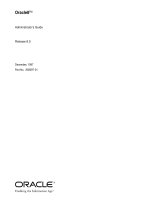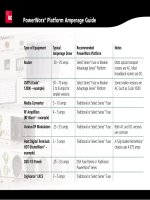Tài liệu Application Developer’s Guide ppt
Bạn đang xem bản rút gọn của tài liệu. Xem và tải ngay bản đầy đủ của tài liệu tại đây (933.71 KB, 128 trang )
Oracle® Data Mining
Application Developer’s Guide
10g Release 1 (10.1)
Part No. B10699-01
December 2003
Oracle Data Mining Application Developer’s Guide, 10g Release 1 (10.1).
Part No. B10699-01
Copyright © 2003 Oracle. All rights reserved.
Primary Authors: Gina Abeles, Ramkumar Krishnan, Mark Hornick, Denis Mukhin, George Tang,
Shiby Thomas, Sunil Venkayala.
Contributors: Marcos Campos, James McEvoy, Boriana Milenova, Margaret Taft, Joseph Yarmus.
The Programs (which include both the software and documentation) contain proprietary information of
Oracle Corporation; they are provided under a license agreement containing restrictions on use and
disclosure and are also protected by copyright, patent and other intellectual and industrial property
laws. Reverse engineering, disassembly or decompilation of the Programs, except to the extent required
to obtain interoperability with other independently created software or as specified by law, is prohibited.
The information contained in this document is subject to change without notice. If you find any problems
in the documentation, please report them to us in writing. Oracle Corporation does not warrant that this
document is error-free. Except as may be expressly permitted in your license agreement for these
Programs, no part of these Programs may be reproduced or transmitted in any form or by any means,
electronic or mechanical, for any purpose, without the express written permission of Oracle Corporation.
If the Programs are delivered to the U.S. Government or anyone licensing or using the programs on
behalf of the U.S. Government, the following notice is applicable:
Restricted Rights Notice Programs delivered subject to the DOD FAR Supplement are "commercial
computer software" and use, duplication, and disclosure of the Programs, including documentation,
shall be subject to the licensing restrictions set forth in the applicable Oracle license agreement.
Otherwise, Programs delivered subject to the Federal Acquisition Regulations are "restricted computer
software" and use, duplication, and disclosure of the Programs shall be subject to the restrictions in FAR
52.227-19, Commercial Computer Software - Restricted Rights (June, 1987). Oracle Corporation, 500
Oracle Parkway, Redwood City, CA 94065.
The Programs are not intended for use in any nuclear, aviation, mass transit, medical, or other inherently
dangerous applications. It shall be the licensee's responsibility to take all appropriate fail-safe, backup,
redundancy, and other measures to ensure the safe use of such applications if the Programs are used for
such purposes, and Oracle Corporation disclaims liability for any damages caused by such use of the
Programs.
Oracle is a registered trademark, and PL/SQL and SQL*Plus are trademarks or registered trademarks of
Oracle Corporation. Other names may be trademarks of their respective owners.
iii
Contents
Send Us Your Comments ix
Preface xi
Intended Audience xi
Structure xi
Where to Find More Information xii
Conventions xiii
Documentation Accessibility xiv
1 Introduction
1.1 ODM Requirements and Constraints 1-2
2 ODM Java Programming
2.1 Compiling and Executing ODM Programs 2-1
2.2 Using ODM to Perform Mining Tasks 2-1
2.2.1 Prepare Input Data 2-2
2.2.2 Build a Model 2-4
2.2.3 Find and Use the Most Important Attributes 2-4
2.2.4 Test the Model 2-5
2.2.5 Compute Lift 2-6
2.2.6 Apply the Model to New Data 2-6
iv
3 ODM Java API Basic Usage
3.1 Connecting to the Data Mining Server 3-1
3.2 Describing the Mining Data 3-2
3.2.1 Creating LocationAccessData 3-2
3.2.2 Creating NonTransactionalDataSpecification 3-2
3.2.3 Creating TransactionalDataSpecification 3-2
3.3 MiningFunctionSettings Object 3-3
3.3.1 Creating Algorithm Settings 3-4
3.3.2 Creating Classification Function Settings 3-4
3.3.3 Validate and Store Mining Function Settings 3-5
3.4 MiningTask Object 3-5
3.5 Build a Mining Model 3-6
3.6 MiningModel Object 3-7
3.7 Testing a Model 3-7
3.7.1 Describe the Test Dataset 3-7
3.7.2 Test the Model 3-8
3.7.3 Get the Test Results 3-8
3.8 Lift Computation 3-9
3.8.1 Specify Positive Target Value 3-9
3.8.2 Compute Lift 3-9
3.8.3 Get the Lift Results 3-10
3.9 Scoring Data Using a Model 3-10
3.9.1 Describing Apply Input and Output Datasets 3-10
3.9.2 Specify the Format of the Apply Output 3-11
3.9.3 Apply the Model 3-11
3.9.4 Real-Time Scoring 3-12
3.10 Use of CostMatrix 3-12
3.11 Use of PriorProbabilities 3-13
3.12 Data Preparation 3-14
3.12.1 Automated Binning and Normalization 3-14
3.12.2 External Binning 3-14
3.12.3 Embedded Binning 3-16
3.13 Text Mining 3-16
3.14 Summary of Java Sample Programs 3-17
v
4 DBMS_DATA_MINING
4.1 Development Methodology 4-2
4.2 Mining Models, Function, and Algorithm Settings 4-3
4.2.1 Mining Model 4-3
4.2.2 Mining Function 4-3
4.2.3 Mining Algorithm 4-3
4.2.4 Settings Table 4-4
4.2.4.1 Prior Probabilities Table 4-10
4.2.4.2 Cost Matrix Table 4-11
4.3 Mining Operations and Results 4-12
4.3.1 Build Results 4-12
4.3.2 Apply Results 4-13
4.3.3 Test Results for Classification Models 4-13
4.3.4 Test Results for Regression Models 4-13
4.3.4.1 Root Mean Square Error 4-13
4.3.4.2 Mean Absolute Error 4-13
4.4 Mining Data 4-14
4.4.1 Wide Data Support 4-14
4.4.1.1 Clinical Data — Dimension Table 4-16
4.4.1.2 Gene Expression Data — Fact Table 4-16
4.4.2 Attribute Types 4-17
4.4.3 Target Attribute 4-17
4.4.4 Data Transformations 4-17
4.5 Performance Considerations 4-18
4.6 Rules and Limitations for DBMS_DATA_MINING 4-18
4.7 Summary of Data Types, Constants, Exceptions, and User Views 4-19
4.8 Summary of DBMS_DATA_MINING Subprograms 4-26
4.9 Model Export and Import 4-27
4.9.1 Limitations 4-28
4.9.2 Prerequisites 4-28
4.9.3 Choose the Right Utility 4-29
4.9.4 Temp Tables 4-29
vi
5 ODM PL/SQL Sample Programs
5.1 Overview of ODM PL/SQL Sample Programs 5-1
5.2 Summary of ODM PL/SQL Sample Programs 5-3
6 Sequence Matching and Annotation (BLAST)
6.1 NCBI BLAST 6-1
6.2 Using ODM BLAST 6-2
6.2.1 Using BLASTN_MATCH to Search DNA Sequences 6-2
6.2.1.1 Searching for Good Matches in DNA Sequences 6-3
6.2.1.2 Searching DNA Sequences Published After a Certain Date 6-3
6.2.2 Using BLASTP_MATCH to Search Protein Sequences 6-4
6.2.2.1 Searching for Good Matches in Protein Sequences 6-4
6.2.3 Using BLASTN_ALIGN to Search and Align DNA Sequences 6-5
6.2.3.1 Searching and Aligning for Good Matches in DNA Sequences 6-5
6.2.4 Output of the Table Function 6-6
6.2.5 Sample Data for BLAST 6-8
Summary of BLAST Table Functions 6-13
BLASTN_MATCH Table Function 6-14
BLASTP_MATCH Table Function 6-17
TBLAST_MATCH Table Function 6-20
BLASTN_ALIGN Table Function 6-23
BLASTP_ALIGN Table Function 6-27
TBLAST_ALIGN Table Function 6-30
7 Text Mining
A Binning
A.1 Use of Automated Binning A-3
B ODM Tips and Techniques
B.1 Clustering Models B-1
B.1.1 Attributes for Clustering B-1
B.1.2 Binning Data for k-Means Models B-1
vii
B.1.3 Binning Data for O-Cluster Models B-2
B.2 SVM Models B-2
B.2.1 Build Quality and Performance B-2
B.2.2 Data Preparation B-2
B.2.3 Numeric Predictor Handling B-3
B.2.4 Categorical Predictor Handling B-3
B.2.5 Regression Target Handling B-4
B.2.6 SVM Algorithm Settings B-4
B.2.7 Complexity Factor (C) B-4
B.2.8 Epsilon — Regression Only B-5
B.2.9 Kernel Cache — Gaussian Kernels Only B-5
B.2.10 Tolerance B-6
B.3 NMF Models B-6
Index
viii
ix
Send Us Your Comments
Oracle Data Mining Application Developer’s Guide, 10g Release 1 (10.1)
Part No. B10699-01
Oracle Corporation welcomes your comments and suggestions on the quality and usefulness of this
document. Your input is an important part of the information used for revision.
■ Did you find any errors?
■ Is the information clearly presented?
■ Do you need more information? If so, where?
■ Are the examples correct? Do you need more examples?
■ What features did you like most?
If you find any errors or have any other suggestions for improvement, please indicate the document
title and part number, and the chapter, section, and page number (if available). You can send com-
ments to us in the following ways:
■ Electronic mail:
■ FAX: 781-238-9893 Attn: Oracle Data Mining Documentation
■ Postal service:
Oracle Corporation
Oracle Data Mining Documentation
10 Van de Graaff Drive
Burlington, Massachusetts 01803
U.S.A.
If you would like a reply, please give your name, address, telephone number, and (optionally) elec-
tronic mail address.
If you have problems with the software, please contact your local Oracle Support Services.
x
xi
Preface
This manual describes using the Oracle Data Mining Java and PL/SQL Application
Programming Interfaces (APIs) to perform data mining tasks for business
applications, bioinformatics, and text mining.
Intended Audience
This manual is intended for anyone planning to write programs using the Oracle
Data Mining Java or PL/SQL interface.
Familiarity with Java or PL/SQL is assumed, as well as familiarity with databases
and data mining.
Users of the Oracle Data Mining BLAST table functions should be familiar with
NCBI BLAST and related concepts.
Structure
This manual is organized as follows:
■ Chapter 1, "Introduction"
■ Chapter 2, "ODM Java Programming"
■ Chapter 3, "ODM Java API Basic Usage"
■ Chapter 4, "DBMS_DATA_MINING"
■ Chapter 5, "ODM PL/SQL Sample Programs"
■ Chapter 6, "Sequence Matching and Annotation (BLAST)"
■ Chapter 7, "Text Mining"
xii
■ Appendix A, "Binning"
■ Appendix B, "ODM Tips and Techniques"
Where to Find More Information
The documentation set for Oracle Data Mining is part of the Oracle 10g Database
Documentation Library. The ODM documentation set consists of the following
documents, available online:
■ Oracle Data Mining Administrator’s Guide, Release 10g
■ Oracle Data Mining Concepts, Release 10g
■ Oracle Data Mining Application Developer’s Guide, Release 10g (this document)
Last-minute information about ODM is provided in the platform-specific README
file.
For detailed information about the Java API, see the ODM Javadoc in the directory
$ORACLE_HOME/dm/doc/jdoc (UNIX) or %ORACLE_HOME%\dm\doc\jdoc
(Windows) on any system where ODM is installed.
For detailed information about the PL/SQL interface, see the Supplied PL/SQL
Packages and Types Reference.
For information about the data mining process in general, independent of both
industry and tool, a good source is the CRISP-DM project (Cross-Industry Standard
Process for Data Mining) ( />Related Manuals
For more information about the database underlying Oracle Data Mining, see:
■ Oracle Administrator’s Guide, Release 10g
■ Oracle Database 10g Installation Guide for your platform.
For information about developing applications to interact with the Oracle Database,
see
■ Oracle Application Developer’s Guide — Fundamentals, Release 10g
For information about upgrading from Oracle Data Mining release 9.0.1 or release
9.2.0, see
■ Oracle Database Upgrade Guide, Release 10g
■ Oracle Data Mining Administrator’s Guide, Release 10g
xiii
For information about installing Oracle Data Mining, see
■ Oracle Installation Guide, Release 10g
■ Oracle Data Mining Administrator’s Guide, Release 10g
Conventions
In this manual, Windows refers to the Windows 95, Windows 98, Windows NT,
Windows 2000, and Windows XP operating systems.
The SQL interface to Oracle is referred to as SQL. This interface is the Oracle
implementation of the SQL standard ANSI X3.135-1992, ISO 9075:1992, commonly
referred to as the ANSI/ISO SQL standard or SQL92.
In examples, an implied carriage return occurs at the end of each line, unless
otherwise noted. You must press the Return key at the end of a line of input.
The following conventions are also followed in this manual:
Convention Meaning
.
.
.
Vertical ellipsis points in an example mean that information not
directly related to the example has been omitted.
. . . Horizontal ellipsis points in statements or commands mean that
parts of the statement or command not directly related to the
example have been omitted
boldface Boldface type in text indicates the name of a class or method.
italic text Italic type in text indicates a term defined in the text, the glossary, or
in both locations.
typewriter In interactive examples, user input is indicated by bold typewriter
font, and system output by plain typewriter font.
typewriter Terms in italic typewriter font represent placeholders or variables.
< >
Angle brackets enclose user-supplied names.
[ ]
Brackets enclose optional clauses from which you can choose one or
none
xiv
Documentation Accessibility
Documentation Accessibility
Our goal is to make Oracle products, services, and supporting documentation
accessible, with good usability, to the disabled community. To that end, our
documentation includes features that make information available to users of
assistive technology. This documentation is available in HTML format, and contains
markup to facilitate access by the disabled community. Standards will continue to
evolve over time, and Oracle Corporation is actively engaged with other
market-leading technology vendors to address technical obstacles so that our
documentation can be accessible to all of our customers. For additional information,
visit the Oracle Accessibility Program Web site at
Accessibility of Code Examples in Documentation
JAWS, a Windows screen reader, may not always correctly read the code examples
in this document. The conventions for writing code require that closing braces
should appear on an otherwise empty line; however, JAWS may not always read a
line of text that consists solely of a bracket or brace.
Introduction 1-1
1
Introduction
Oracle Data Mining embeds data mining in the Oracle database. The data never
leaves the database — the data, data preparation, model building, and model
scoring activities all remain in the database. This enables Oracle to provide an
infrastructure for data analysts and application developers to integrate data mining
seamlessly with database applications.
Oracle Data Mining is designed for programmers, systems analysts, project
managers, and others interested in developing database applications that use data
mining to discover hidden patterns and use that knowledge to make predictions.
There are two interfaces: a Java API and a PL/SQL API. The Java API assumes a
working knowledge of Java, and the PL/SQL API assumes a working knowledge of
PL/SQL. Both interfaces assume a working knowledge of application programming
and familiarity with SQL to access information in relational database systems.
This document describes using the Java and PL/SQL interface to write application
programs that use data mining. It is organized as follows:
■ Chapter 1 introduces ODM.
■ Chapter 2 and Chapter 3 describe the Java interface. Chapter 2 provides an
overview; Chapter 3 provides details. Reference information for methods and
classes is available with Javadoc. The demo Java programs are described in
Table 3–1. The demo programs are available as part of the installation; see the
README file for details.
■ Chapter 4 and Chapter 5 describe the PL/SQL interface. Basics are described
inChapter 4, and demo PL/SQL programs are described in Chapter 5.
■ Reference information for the PL/SQL functions and procedures is included in
the PL/SQL Packages and Types Reference. The demo programs themselves are
available as part of the installation; see the README file for details.
ODM Requirements and Constraints
1-2 Oracle Data Mining Application Developer’s Guide
■ Chapter 6 describes programming with BLAST, a set of table functions for
performing sequence matching searches against nucleotide and amino acid
sequence data stored in an Oracle database.
■ Chapter 7 describes how to use the PL/SQL interface to do text mining.
■ Appendix A contains an example of binning.
■ Appendix B provides tips and techniques useful in both the Java and the
PL/SQL interface.
1.1 ODM Requirements and Constraints
Anyone writing an Oracle Data Mining program must observe the following
requirements and constraints:
■ Attribute Names in ODM: All attribute names in ODM are case-sensitive and
limited to 30 bytes in length; that is, attribute names may be quoted strings that
contain mixed-case characters and/or special characters. Simply put, attribute
names used by ODM follow the same naming conventions and restrictions as
column names or type attribute names in Oracle.
■ Mining Object Names in ODM: All mining object names in ODM are 25 or
fewer bytes in length and must be uppercase only. Model names may contain
the underscore ("_") but no other special characters. Certain prefixes are
reserved by ODM (see below) and should not be used in mining object names.
■ ODM Reserved Prefixes: The prefixes DM$ and DM_ are reserved for use by
ODM across all schema object names in a given Oracle instance.
Users must not directly access these ODM internal tables, that is, they should
not execute any DDL, Query, or DML statements directly against objects named
with these prefixes. Oracle recommends that you rename any existing objects in
the database with these prefixes to avoid confusion in your application data
management.
■ Input Data for Programs Using ODM: All input data for ODM programs must
be presented to ODM as an Oracle-recognized table, whether a view, table, or
table function output.
ODM Java Programming 2-1
2
ODM Java Programming
This chapter provides an overview of the steps required to perform basic Oracle
Data Mining tasks and discusses the following topics related to writing data mining
programs using the Java interface:
■ The requirements for compiling and executing programs.
■ How to perform common data mining tasks.
Detailed demo programs are provided as part of the installation.
2.1 Compiling and Executing ODM Programs
Oracle Data Mining depends on the following Java archive (.jar) files:
$ORACLE_HOME/dm/lib/odmapi.jar$ORACLE_HOME/jdbc/lib/ojdbc14.jar
$ORACLE_HOME/jlib/orai18n.jar
$ORACLE_HOME/lib/xmlparserv2.jar
These files must be in your CLASSPATH to compile and execute Oracle Data Mining
programs.
2.2 Using ODM to Perform Mining Tasks
This section describes the steps required to perform several common data mining
tasks using Oracle Data Mining. Data mining tasks are usually performed in a
particular sequence. The following sequence is typical:
1. Collect and preprocess (bin or normalize) data. (This step is optional; ODM
algorithms can automatically prepare input data.)
2. Build a model
Using ODM to Perform Mining Tasks
2-2 Oracle Data Mining Application Developer’s Guide
3.
Test the model and calculate lift (classification problems only)
4. Apply the model to new data
All work in Oracle Data Mining is done using MiningTask objects.
To implement a sequence of dependent task executions, you may periodically check
the asynchronous task execution status using the getCurrentStatus method or
block for completion using the waitForCompletion method. You can then
perform the dependent task after completion of the previous task.
For example, follow these steps to perform the build, test, and compute lift
sequence:
■ Perform the build task as described in Section 2.2.2 below.
■ After successful completion of the build task, start the test task by calling the
execute method on a ClassificationTestTask or RegressionTestTask
object. Either periodically check the status of the test operation or block until
the task completes.
■ After successful completion of the test task, execute the compute lift task by
calling the execute method on a MiningComputeLiftTask object.
You now have (with a little luck) a model that you can use in your data mining
application.
2.2.1 Prepare Input Data
Different algorithms require different preparation and preprocessing of the input
data. Some algorithms require normalization; some require binning (discretization).
In the Java interface the algorithms can prepare data automatically.
This section summarizes the steps required for different data preparation
methodologies supported by the ODM Java API.
Automated Discretization (Binning) and Normalization
The ODM Java interface supports automated data preparation. If the user specifies
active unprepared attributes, the data mining server automatically prepares the
data for those attributes.
In the case of algorithms that use binning as the default data preparation, bin
boundary tables are created and stored as part of the model. The model’s bin
boundary tables are used for the data preparation of the dataset used for testing or
Using ODM to Perform Mining Tasks
ODM Java Programming 2-3
scoring using that model. In the case of algorithms that use normalization as the
default data preparation, the normalization details are stored as part of the model.
The model uses those details for preparing the dataset used for testing or scoring
using that model.
The algorithms that use binning as the default data preparation are Naive Bayes,
Adaptive Bayes Network, Association, k-Means, and O-Cluster. The algorithms that
use normalization are Support Vector Machines and Non-Negative Matrix
Factorization. For normalization, the ODM Java interface supports only the
automated method.
External Discretization (Binning)
For certain distributions, you may get better results if you bin the data before the
model is built.
External binning consists of two steps:
■ The user creates binning specification either explicitly or by looking at the data
and using one of the predefined methods. For categorical attributes, there is
only one method: Top-N Frequency. For numerical attributes, there are two
methods: Equi-width and equi-width with winsorizing.
■ The user bins the data following the specification created.
Specifically, the steps for external binning are as follows:
1. Create DiscretizationSpecification objects to specify the bin boundary
specifications for the attributes.
2. Call Transformation.createDiscretizationTables method to create
bin boundaries
3. Call Transformation.discretize method to discretize/bin the data.
Note that in the case of external binning, the user needs to bin the data consistently
for all build, test, apply, and lift operations.
Embedded Discretization (Binning)
Embedded binning allows users to define their own customized automated
binning. The binning strategy is specified by providing a bin boundary table that is
produced by the bin specification creation step of external binning.
Specifically, the steps for embedded binning are as follows:
1. Create DiscretizationSpecification objects to specify the bin boundary
specifications for the attributes.
Using ODM to Perform Mining Tasks
2-4 Oracle Data Mining Application Developer’s Guide
2.
Call the Transformation.createDiscretizationTables method to
create bin boundaries.
3. Call the setUserSuppliedDiscretizationTables method in the
LogicalDataSpecification object to attach the user created bin
boundaries tables with the mining function settings object.
Keep in mind that because binning can have an effect on a model’s accuracy, it is
best when the binning is done by an expert familiar with the data being binned and
the problem to be solved. However, if there is no additional information that can
inform decisions about binning or if what is wanted is an initial exploration and
understanding of the data and problem, ODM can bin the data using default
settings, either by explicit user action or as part of the model build.
ODM groups the data into 5 bins by default. For categorical attributes, the 5 most
frequent values are assigned to 5 different bins, and all remaining values are
assigned to a 6th bin. For numerical attributes, the values are divided into 5 bins of
equal size according to their order.
After the data is processed, you can build a model.
For an illustration of binning, see Appendix A.
2.2.2 Build a Model
This section summarizes the steps required to build a model.
1. Prepocess and prepare the input data as required.
2. Construct and store a MiningFunctionSettings object.
3. Construct and store a MiningBuildTask object.
4. Call the execute method; the execute method queues the work for asynchronous
execution and returns an execution handle to the caller.
5. Periodically call the getCurrentStatus method to get the status of the task.
Alternatively, use the waitForCompletion method to wait until all
asynchronous activity for task completes.
After successful completion of the task, a model object is created in the database.
2.2.3 Find and Use the Most Important Attributes
Models based on data sets with a large number of attributes can have very long
build times. To minimize build time, you can use ODM Attribute Importance to
identify the critical attributes and then build a model using only these attributes.
Using ODM to Perform Mining Tasks
ODM Java Programming 2-5
Build an Attribute Importance Model
Identify the most important attributes by building an Attributes Importance model
as follows:
1. Create a Physical Data Specification for input data set.
2. Discretize (bin) the data if required.
3. Create and store mining settings for the Attribute Importance.
4. Build the Attribute Importance model.
5. Access the model and retrieve the attributes by threshold.
Build a Model Using the Selected Attributes
After identifying the important attributes, build a model using the selected
attributes as follows:
1. Access the model and retrieve the attributes by threshold or by rank.
2. Modify the Data Usage Specification by calling the function
adjustAttributeUsage defined on MiningFunctionSettings. Only the
attributes returned by Attribute Importance will be active for model building.
3. Build a model using the new Mining Function Settings.
2.2.4 Test the Model
This section summarizes the steps required to test a classification or a regression
model.
1. Preprocess the test data as required. Test data must have all the active attributes
used in the model and the target attribute in order to assess the model’s
accuracy.
2. Prepare (bin or normalize) the input data the same way the data was prepared
for building the model.
3. Construct and store a task object. For classification problems, use
ClassificationTestTask; for regression, use RegressionTestTask.
4. Call the execute method; the execute method queues the work for
asynchronous execution and returns an execution handle to the caller.
5. Periodically, call the getCurrentStatus method to get the status of the task.
As an alternative, use the waitForCompletion method to wait until all
asychronous activity for the task completes.
Using ODM to Perform Mining Tasks
2-6 Oracle Data Mining Application Developer’s Guide
6.
After successful completion of the task, a test result object is created in the DMS.
For classification problems, the results are represented using
ClassificaionTestResult object; for regression problems, results are
represented using RegressionTestResult object.
2.2.5 Compute Lift
This section summarizes the steps required to compute lift using a classification
model.
1. Lift operation is typically done using the test data. Data preparation steps
described in the section above also apply to the lift operation.
2. Construct and store a MiningLiftTask object.
3. Call the execute method; the execute method queues the work for
asynchronous execution and returns an execution handle to the caller.
4. Periodically, call the getCurrentStatus method to get the status of the task.
As an alternative, use the waitForCompletion method to wait until all
asychronous activity for the task completes.
5. After successful completion of the task, a MiningLiftResult object is created
in the DMS.
2.2.6 Apply the Model to New Data
You make predictions by applying a model to new data, that is, by scoring the data.
Any table that you score (apply a model to) must have the same format as the table
used to build the model. If you build a model using a table that is in multi-record
(transactional) format , any table that you apply that model to must be in
multi-record format. Similarly, if the table used to build the model was in
nontransactional (single-record) format, any table to which you apply the model
must be in nontransactional format.
Note that you can score a single record, which must also be in the same format as
the table used to build the model.
The steps required to apply a classification, clustering, or a regression model are as
follows:
1. Preprocess the apply data as required. The apply data must have all the active
attributes that were present in creating the model.
Using ODM to Perform Mining Tasks
ODM Java Programming 2-7
2.
Prepare (bin or normalize) the input data the same way the data was prepared
for building the model. If the data was prepared using the automated option at
build time, then the apply data is also prepared using the automated option and
other preparation details from building the model.
3. Construct and store a MiningApplyTask object. The MiningApplyOutput
object is used to specify the format of the apply output table.
4. Call the execute method; the execute method queues the work for
asynchronous execution and returns an execution handle to the caller.
5. Periodically, call the getCurrentStatus method to get the status of the task.
As an alternative, use the waitForCompletion method to wait until all
asynchronous activity for the task completes.
6. After successful completion of the task, a MiningApplyResult object is
created in the DMS and the apply output table/view is created at the
user-specified name and location.
Using ODM to Perform Mining Tasks
2-8 Oracle Data Mining Application Developer’s Guide
ODM Java API Basic Usage 3-1
3
ODM Java API Basic Usage
This chapter describes how to use the ODM Java interface to write data mining
applications in Java. Our approach in this chapter is to use a simple example to
describe the use of different features of the API.
For detailed descriptions of the class and method usage, refer to the Javadoc that is
shipped with the product. See the administrator’s guide for the location of the
Javadoc.
3.1 Connecting to the Data Mining Server
To perform any mining operation in the database, first create an instance of
oracle.dmt.odm.DataMiningServer class. This instance is used as a proxy to
create connections to a data mining server (DMS), and to maintain the connection.
The DMS is the server-side, in-database component that performs the actual data
mining operations within ODM. The DMS also provides a metadata repository
consisting of mining input objects and result objects, along with the namespaces
within which these objects are stored and retrieved.
In this step, we illustrate creating a DataMiningServer object and then logging in
to get the connection. Note that there is a logout method to release all the
resources held by the connection
// Create an instance of the DMS server and get a connection.
// The database JDBC URL, user_name, and password for data mining
// user schema
DataMiningServer dms = new DataMiningServer(
"DB_URL",// JDBC URL jdbc:oracle:thin:@Host name:Port:SID
"user_name",
"password");
//Login to get the DMS connection
oracle.dmt.odm.Connection m_dmsConn = dms.login();
